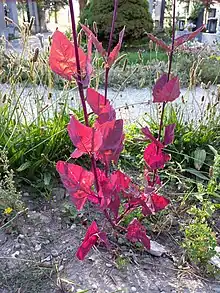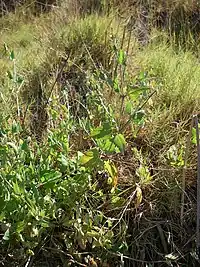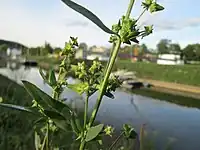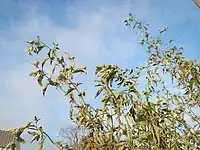Reconstruction:Proto-Slavic/loboda
Proto-Slavic




Etymology
Of uncertain kinship. Relatable to Lithuanian balánda and Latvian balodene (“goosefoot (Chenopodium); orach (Atriplex gen. et spp.)”), and even a distant relationship to Proto-Germanic *meldǭ (“goosefoot; orach”) cannot be excluded. A derivation from Proto-Indo-European *albʰós (“white”) begs the semantical question whether there are characteristic white parts with the orach or chenopod, any more relevantly than to artificially find the name Chenopodium album. Ancient Greek λάπαθον (lápathon, “sorrel”, a meaning also present in Turkish) may be related by being borrowed from an Indo-European language close to Balto-Slavic as Dacian, Thracian, or Illyrian, connected to Albanian lëpjetë (“sorrel”), wheras Ancient Greek βλῐ́τον (blíton, “purple amaranth”) might be an inherited cognate.
Cihac suggests that the word is interrelated with Hungarian láb (“foot, leg”) and thus derives from Uralic, comparing Romanian laba gâștei (“chenopod”, literally “goose paw”), syn. talpa gâștei (“goose sole”), and the botanical Chenopodium from χήν (khḗn, “goose”) + πούς (poús, “foot”) (but most of such like German Gänsefuß (“chenopod”) and English goosefoot are calqued from the taxonomic; instead compare Middle Armenian բազուկ (bazuk, “beet”, literally “arm”)). Nonetheless Georg Holzer ascribes the word to the Indo-European substrate he calls “Temematic”, deriving in it as a bahúvrīhi compound of Proto-Indo-European *h₁el- (“goose”, according to him) and *pṓds (“foot”).
Of the same origin is a Common Turkic term *(a)labVda everywhere meaning plants of the Atripliceae syn. Chenopodieae tribe that is not found in Chuvash or Yakut.
Descendance from Proto-Iranian *(h)rabā́š ~ *(h)rabacáh (“rhubarb”) (see there for more) may explain this geographical picture, rhubarb (Rheum) and sorrel (Rumex) anciently being confusables of the same botanical tribe, compare the concept of monk's rhubarb (Rumex alpinus and Rumex patientia, which is also a meaning of Ancient Greek λάπαθον (lápathon), with superficial similarity to the orach (Atriplex) and goosefoot (Chenopodium) vegetable plants.
Inflection
| Singular | Dual | Plural | |
|---|---|---|---|
| Nominative | *loboda | *lobodě | *lobody |
| Accusative | *lobodǫ | *lobodě | *lobody |
| Genitive | *lobody | *lobodu | *lobodъ |
| Locative | *lobodě | *lobodu | *lobodasъ, *lobodaxъ* |
| Dative | *lobodě | *lobodama | *lobodamъ |
| Instrumental | *lobodojǫ, *lobodǫ** | *lobodama | *lobodami |
| Vocative | *lobodo | *lobodě | *lobody |
** The second form occurs in languages that contract early across /j/ (e.g. Czech), while the first form occurs in languages that do not (e.g. Russian).
Descendants
- East Slavic:
- South Slavic:
- West Slavic:
- → Albanian: labót, labotë, labod, lebotë, llabod, llabudë, llabod
- → Greek: λουβουδιά (louvoudiá), λουβοδιά (louvodiá), λοβουδιά (lovoudiá), λοβοδιά (lovodiá), λοβοδά (lovodá), λομπότι (lompóti), λομποτιά (lompotiá), λομποτή (lompotí), λομπουντιά (lompountiá), λομπουτιά (lompoutiá), λοποντιά (lopontiá), λοποτιά (lopotiá), λεπουντιά (lepountiá), λεποντιά (lepontiá), λεποντή (lepontí), λεβουδιά (levoudiá), λοβοδό (lovodó), λάπατα (lápata), λαμποτιά (lampotiá), λαβουδιά (lavoudiá), λειβαδία (leivadía), λειβάδιον (leivádion)
- → Hungarian: laboda
- → Romanian: lobodă
- →? Proto-Turkic: *alabuda
References
- Bezlaj, France (1982) Etimološki slovar slovenskega jezika, volume 2, Ljubljana, page 147
- Blau, Otto (1868) Bosnisch-türkische Sprachdenkmäler, Berlin: F. A. Brockhaus, page 156
- Cihac, Alexandru (1879) Dictionnaire d’étymologie daco-romane: éléments slaves, magyars, turcs, grecs-moderne et albanais (in French), volume 2, Frankfurt: Ludolphe St-Goar, page 175
- Holzer, Georg (1989) Entlehnungen aus einer bisher unbekannten indogermanischen Sprache im Urslavischen und Urbaltischen (in German), Wien: Verlag der Österreichischen Akadamie der Wissenschaften, →ISBN, pages 60–64
- Nişanyan, Sevan (2002–), “labada”, in Nişanyan Sözlük
- Svane, Gunnar (1992) Slavische Lehnwörter im Albanischen (Acta Iutlandica. Humanistische Reihe; 67) (in German), Åarhus: Aarhus University Press, →ISBN, page 114
- Trubachyov, Oleg, editor (1979), “*elbeda”, in Этимологический словарь славянских языков [Etymological Dictionary of Slavic Languages] (in Russian), issue 6 (*e – *golva), Moscow: Nauka, page 18
- Trubachyov, Oleg, Zhuravlyov, A. F., editors (2005), “*olboda”, in Этимологический словарь славянских языков [Etymological Dictionary of Slavic Languages] (in Russian), issue 32 (*obžьnъ – *orzbotati), Moscow: Nauka, →ISBN, page 50
- Vasmer, Max (1964–1973), “лебеда”, in Этимологический словарь русского языка [Etymological Dictionary of the Russian Language] (in Russian), transl. and suppl. by Oleg Trubachyov, Moscow: Progress